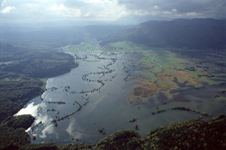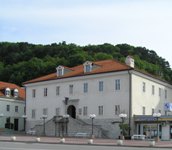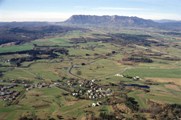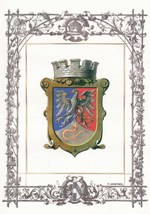|  |
 |  | | Postojna city |
|

|
The history of POSTOJNA is rich and ancient. The tools made of stone found in the Postojna Cave, Otok Cave, Loza Cave, Fumigated Cave (Zakajeni spodmol) and Betalov spodmol testify that Postojna with its surroundings was densely populated already in the paleolithic. The remnants of pottery, tools and ornaments made of bone from Predjama, the Postojna Cave and Betalov spodmol prove that the caves sheltered also people in the neolithic. It is known that people in the Bronze Age and Iron Age lived in the fortified settlements on the hills. Their high – level culture which can be seen through the remnants such as jewellery, tools and arms, was present with its characteristic form in the whole Notranjska.
|
|
The history of POSTOJNA is rich and ancient. The tools made of stone found in the Postojna Cave, Otok Cave, Loza Cave, Fumigated Cave (Zakajeni spodmol) and Betalov spodmol testify that Postojna with its surroundings was densely populated already in the paleolithic. The remnants of pottery, tools and ornaments made of bone from Predjama, the Postojna Cave and Betalov spodmol prove that the caves sheltered also people in the neolithic. It is known that people in the Bronze Age and Iron Age lived in the fortified settlements on the hills. Their high – level culture which can be seen through the remnants such as jewellery, tools and arms, was present with its characteristic form in the whole Notranjska.
|

|
|

|
During the Roman Empire the Pivka valley assumed the role of a transit area, while the early Middle Ages did not leave any important vestiges. Postojna was first mentioned in the sources in 1226, It was referred to as the Postojna village (villa de Arnesperch) in 1262. The Slovene name Postoyna (Posthojma) appeared in 1369. During the decline of the Aquileia's property, Postojna was won by the Hasburgs in 1371, when they were advancing towards the Adriatic Sea. The village of Postojna was located near the important commercial route between Ljubljana, Trieste and Rijeka which linked the Hasburgs' property in the Karst to their property in the Littora, therefore they raised the Postojna village with the castle, which was the seat of their propery and the Pivka and Karst administrative districts, to the borough in 1432.
|
|
The Postojna castle, located on the hill called Sovič, was the seat of the property. In 1689 it was destroyed by the fire caused by the lightning and it was not restored. The new castle, which became the seat of the administrative authorities in the 18th century, was built in the centre of the borough. The »Emperor Road« from Ljubljana, through Vrhnika and Planina to Postojna and from Postojna to Rijeka or through Razdrto and Senožeče to Trieste on the one hand and the heavy traffic on the other hand raised the Postojna village to the borough and to the town in the next four hundred years. Due to this very road which was replaced by the railway in 1857 and the famous Postojna Cave, Postojna was awarded the honourable title of the town in 1909. Postojna has been the seat of administrative and other offices since 1748 when it became the seat of the Notranjska district. After restructuring of administration in the middle of the nineteenth century, the Notranjska district offices were replaced by prefecture. Between the two wars Postojna was a frontier town in Italy
|

|
|

|
Postojna was not only an administrative but also cultural and educational centre as well as medical one.
Postojna got its first school – building in 1810 and as a developing borough it introduced the school for crafts and in 1906 the secondary boys' school, the first school with the Slovene language in the whole Austro – Hungarian monarchy.
The Postojna hospital was opened in 1853. Electricity came to the borough in 1901 and Postojna got its first water – supply in 1902. Despite the fact that Postojna became the seat of the administrative district Notranjska during the reign of Marija Terezija, it did not have its own parish. It belonged to the original Slavina parish. Postojna became the seat of the new parish in 1794 but the borough got a new, monumental St. Stephen's church even before the establishing of the parish. The project was designed by the architect Leopold Hofer in 1777 while the paintings on the walls were made by Andrej Herling and Domenico Fabrio.
|
| After the discovery of the inner parts of the Postojna Cave, Postojna became a world – famous tourist town (the first luyurious hotel Adelsbergerhof was built in 1874) and the starting – point for visiting other points of interest in the Karst. |

|
|

|
The present Postojna is a modern, nice and kind town which still attracts numerous guests showing its natural, cultural and historical particularities. In Postojna, rapidly becoming the world's karstology centre, there is Karst Research Insitute (Inštitut za raziskovanje krasa ZRC SAZU), with its seat in the Postojna castle. It attracts more and more home and foreign researchers with its rich research activities (geology, tectonics, mineralogy, hydrogeology, hydrochemistry,water current tracing, geomorphology and speleology), speleological collection, cave register and rich library with 30.000 pieces about karst.
|
|
The present Postojna is a modern, nice and kindtown which still attracts numerous guests showing its natural, cultural andhistorical particularities. In Postojna, rapidly becoming the world's karstologycentre, there is Karst Research Insitute (Inštitut za raziskovanje krasa ZRCSAZU), with its seat in the Postojna castle. It attracts more and more home andforeign researchers with its rich research activities (geology, tectonics,mineralogy, hydrogeology, hydrochemistry,water current tracing, geomorphologyand speleology), speleological collection, cave register and rich library with30.000 pieces about karst.
Alenka Čuk, Alma Bavdek
The Notranjska museum Postojna
|

|
|  |
|